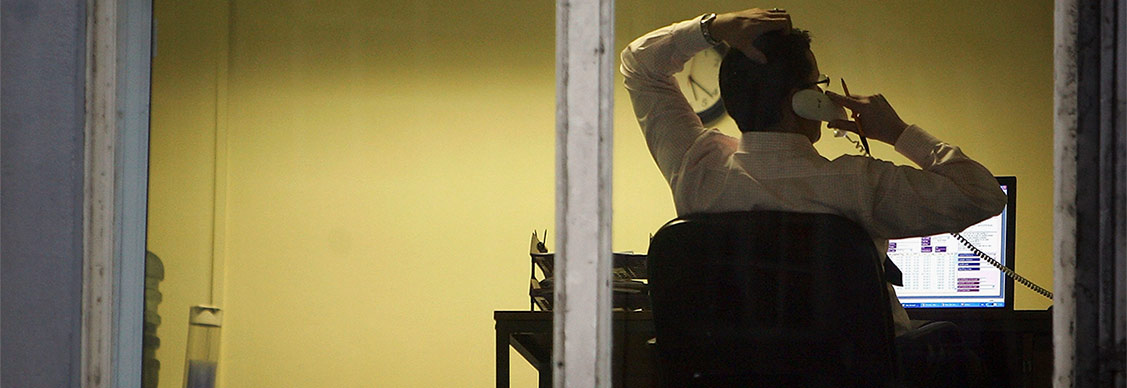White collar workers are languishing. Can office design help?
Companies look to new types of spaces for mental health benefits.
Sally Henderson*, a middle-aged consultant at a financial services firm, hardly thought of herself as an extrovert.
She always thought she’d relish the opportunity to work from home, where there were fewer distractions. But as the pandemic and lockdowns reached the one-year mark, she realized she was less able to focus. With days and weeks seeming the same, she lost a sense of time and purpose, she says.
The feeling is familiar to many people working from home in the past year. It’s not burnout or depression, but a persistent sense of joylessness called “languishing.” Its telltale sign is an aimlessness emerging as days blend together. Over 50% of employees identify as feeling “stuck” this year, according to BetterUp.
“Languishing is a sense of stagnation and emptiness,” says organizational psychologist Adam Grant in an article on the topic. “It feels as if you’re muddling through your days, looking at your life through a foggy windshield.”
For Henderson, the experience was so subtle that she didn’t realize how hard it had been until she was back in the office two times as a week as part of her employer’s hybrid work pilot program. A sense of focus returned, even though she dreaded the commute.
As vaccinated employees begin to return to the office, companies are keen to offer a break from the monotony of home that Henderson experienced. This largely involves creating office experiences that mix things up. Everything from color therapy rooms to rooftop spaces that allow for a change of scenery are being considered, especially as a labor shortage and high rates of job-hopping have employers firmly focused on attracting and retaining talented employees.
The Offices at Essex Crossing on Manhattan’s Lower East Side, under construction during the pandemic, includes outdoor spaces like private terraces so that people can work in different environments.
While languishing may be “the dominant emotion of 2021,” says Grant, efforts to combat stagnation at work was trending before lockdowns poured fuel on the mental health fire. The InteriorWorks office in Amsterdam, for example, was built in 2019 to include a variety of work and meeting spaces, varying floor and ceiling heights, and multiple pathways to create a sense of differing spaces that encourage movement through the office. In the atrium of the Kajima office in Tokyo, aroma and bio-music are used intermittently to provide variety and stimulation.
“Companies need to address mental wellness before it rises to the level of mental distress,” says Melissa Walker, Director, Wellbeing Product Lead, Experience Services, JLL. “We have been having a lot more conversations with leaders about how workplace design can help employees feel energized, connected and engaged.”
Looking for more insights? Never miss an update.
The latest news, insights and opportunities from global commercial real estate markets straight to your inbox.
Mixing it up
When companies think about how to counter the “blahs” with workplace design, many are reconsidering amenities.
Fitness centers, while touted as a great recruitment tool, were underutilized long before the pandemic, says Lori Louis, Global Product Owner, JLL. While many employees said they’d appreciate a gym at the office, few actually used it, Louis says.
“Right now, we’re helping organizations move away from just physical wellness to a greater focus on emotional, mental and cognitive wellness,” she says. “The majority of white-collar workers have probably figured out how to take care of physical fitness elsewhere in last year. What kinds of amenities give people a break from the emotional and mental toll that life can take?”
Color therapy rooms are an emerging option, Walker says. “I came from the spa industry, where it was an accepted practice,” she says. “It is newer to think about this in the office space.”
Blue light could be effective for languishing, Walker says, because it helps with both focus and creativity.
Also important for languishing are spaces that encourage breaks and socialization significantly different from the rest of the office.
“It helps to invigorate people with something they can't get at home,” Louis says.
Outdoor spaces
Access to outdoor space has been proven to improve both physical and mental health, says Christina Piper, Vice President, Workplace Design, JLL.
Take Corporate Commons Three building on Staten Island. Fruits and vegetables grown on the roof are used in the building’s ground-floor restaurant. But the roof is also a place that can take employees away from their to-do lists.
Piper says this may be the biggest change emerging from the pandemic: the shift toward an indoor-outdoor workplace — at least, when weather permits.
The SAP offices in Johannesburg, for example, combine open-plan individual workstations with breakout areas for focus or collaboration, informal work zones and enclosed concentration rooms, as well as patios, balconies and a pond for outdoor gatherings.
The key, Piper says, is to make it accessible.
“We’re partnering with Big Red Rooster to explore the possibility of adding greenhouses to hi-rises in cities such as New York,” Louis says. “It’s all about creating that opportunity to connect with nature even in a dense, urban environment.”
But actually getting workers to partake in these offerings is part of the challenge.
“In the early 2000s, we had plenty of pool tables but no policies that encouraged people to take breaks,” Piper says. “Now I tell leaders, if you want employees to use this space, you need to use it and set the example.”
*Name has been changed for anonymity
